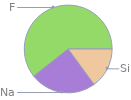Input interpretation

sodium fluorosilicate | elemental composition
Result

Find the elemental composition for sodium fluorosilicate in terms of the atom and mass percents: atom percent = N_i/N_atoms × 100% mass percent = (N_im_i)/m × 100% Plan: • Write the chemical formula and gather atomic masses from the periodic table. • Determine values for N_i, m_i, N_atoms and m using these items. • Finally, compute the percents and check the results. Write the chemical formula: Na_2SiF_6 Use the chemical formula, Na_2SiF_6, to count the number of atoms, N_i, for each element and find the total number of atoms, N_atoms: | number of atoms F (fluorine) | 6 Na (sodium) | 2 Si (silicon) | 1 N_atoms = 6 + 2 + 1 = 9 Divide each N_i by N_atoms to calculate atom fractions. Then use the property that atom fractions must sum to one to check the work: | number of atoms | atom fraction F (fluorine) | 6 | 6/9 Na (sodium) | 2 | 2/9 Si (silicon) | 1 | 1/9 Check: 6/9 + 2/9 + 1/9 = 1 Compute atom percents using the atom fractions: | number of atoms | atom percent F (fluorine) | 6 | 6/9 × 100% = 66.7% Na (sodium) | 2 | 2/9 × 100% = 22.2% Si (silicon) | 1 | 1/9 × 100% = 11.1% Look up the atomic mass, m_i, in unified atomic mass units, u, for each element in the periodic table: | number of atoms | atom percent | atomic mass/u F (fluorine) | 6 | 66.7% | 18.998403163 Na (sodium) | 2 | 22.2% | 22.98976928 Si (silicon) | 1 | 11.1% | 28.085 Multiply N_i by m_i to compute the mass for each element. Then sum those values to compute the molecular mass, m: | number of atoms | atom percent | atomic mass/u | mass/u F (fluorine) | 6 | 66.7% | 18.998403163 | 6 × 18.998403163 = 113.990418978 Na (sodium) | 2 | 22.2% | 22.98976928 | 2 × 22.98976928 = 45.97953856 Si (silicon) | 1 | 11.1% | 28.085 | 1 × 28.085 = 28.085 m = 113.990418978 u + 45.97953856 u + 28.085 u = 188.054957538 u Divide the mass for each element by m to calculate mass fractions. Then use the property that mass fractions must sum to one to check the work: | number of atoms | atom percent | mass fraction F (fluorine) | 6 | 66.7% | 113.990418978/188.054957538 Na (sodium) | 2 | 22.2% | 45.97953856/188.054957538 Si (silicon) | 1 | 11.1% | 28.085/188.054957538 Check: 113.990418978/188.054957538 + 45.97953856/188.054957538 + 28.085/188.054957538 = 1 Compute mass percents using the mass fractions: Answer: | | | number of atoms | atom percent | mass percent F (fluorine) | 6 | 66.7% | 113.990418978/188.054957538 × 100% = 60.62% Na (sodium) | 2 | 22.2% | 45.97953856/188.054957538 × 100% = 24.45% Si (silicon) | 1 | 11.1% | 28.085/188.054957538 × 100% = 14.93%
Mass fraction pie chart

Mass fraction pie chart